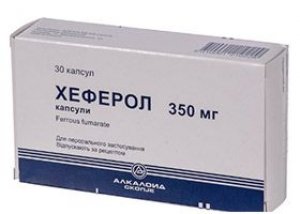
All iLive content is medically reviewed or fact checked to ensure as much factual accuracy as possible.
We have strict sourcing guidelines and only link to reputable media sites, academic research institutions and, whenever possible, medically peer reviewed studies. Note that the numbers in parentheses ([1], [2], etc.) are clickable links to these studies.
If you feel that any of our content is inaccurate, out-of-date, or otherwise questionable, please select it and press Ctrl + Enter.
Heferol
Medical expert of the article
Last reviewed: 03.07.2025

Heferol helps to replenish the lack of iron in the body. This substance is an important element that takes part in the process of synthesizing hemoglobin and other globin enzymes.
ATC classification
Active ingredients
Pharmacological group
Pharmachologic effect
Indications Heferol
Treatment and prevention of iron deficiency anemia.
Increased iron loss: bleeding from the digestive tract (gastric ulcer and duodenal ulcer, ulcerative colitis, polyposis, hemorrhoids), bleeding from the urogenital tract (polymenorrhea, hypermenorrhea, metrorrhagia, hematuria), with fibromyomatosis, bleeding of various origins.
Increased need of the body for iron: period of intensive growth and sexual development, pregnancy, breastfeeding.
Insufficient iron intake: reduced intake with food, impaired iron absorption in malabsorption syndrome, presence of inflammatory diseases of the digestive tract.
Release form
Available in capsules - 30 pcs in 1 bottle. One package contains one bottle. Also available in blisters - 10 capsules each. One package contains 3 blister strips.
Pharmacodynamics
Heferol contains ferrous fumarate (ferrous iron). This substance promotes the process of erythropoiesis occurring in the bone marrow, and is also a component of hemoglobin (approximately two-thirds of all iron), as well as myoglobin and individual enzymes. Insufficient iron intake from the outside or problems with its absorption in the body can cause the development of latent or clinically expressed iron deficiency anemia.
Pharmacokinetics
Iron absorption occurs in the intestines, in the process of sequential release of the substance from the capsules. If a person is healthy, approximately 10-15% of the consumed dose is absorbed. And if the patient has an iron deficiency, absorption increases to 25-30%. Excretion from the body occurs through the kidneys (minimum substance), and in addition with bile and feces. In nursing mothers, approximately 0.25 mg / day gets into the milk.
Dosing and administration
The drug should be taken on an empty stomach before breakfast, half an hour before it. The capsule should be washed down with plenty of water. For children over 12 years old and adults, the dosage is 2 capsules/day in 1 or 2 doses (for treatment) and 1 capsule (for prevention). The treatment course can be 6-12 weeks. Use of the drug continues until the blood counts are normalized (approximately 3-4 months).
 [ 1 ]
[ 1 ]
Use Heferol during pregnancy
No negative effects on the fetus have been noted when the drug is used by a pregnant woman.
Contraindications
Among the contraindications:
- Hypersensitivity to the components of the drug;
- Anemias that are not associated with iron deficiency (such as megaloblastic, which occurs due to a deficiency of vitamin B12; as well as hemolytic);
- Acute intestinal obstruction or diverticulosis;
- Iron-saturated anemia (lead);
- Hemosiderosis;
- Regular blood transfusions;
- Concomitant treatment with iron-containing drugs by intravenous infusions.
Side effects Heferol
Side effects of taking Heferol may include the following reactions: discomfort or pain in the epigastrium, vomiting with nausea, constipation or diarrhea, black stool, allergies of varying severity. Unreasonable prolonged use of the drug may cause the development of hemosiderosis.
Overdose
Acute overdose is manifested by the following symptoms: pain in the epigastrium and vomiting with nausea, as well as melena and diarrhea. In this case, pallor, drowsiness, and cyanosis of the skin may also be observed. If the case is severe, shock or collapse may occur, and in some cases, a coma and death. In case of internal use, the lethal dose is 180-300 mg/kg of weight. Sometimes a dosage of 30 mg/kg can also become toxic. The appearance of signs of overdose occurs 1 hour or several hours after taking the drug.
Treatment: induce vomiting and gastric lavage. Deferoxamine acts as a specific antidote. Chelation with deferoxamine is used:
- if the dosage of iron fumarate consumed is 180-300+ mg/kg;
- the iron saturation index in the blood serum exceeds 400 mg%;
- the iron saturation level in the blood serum becomes higher than the total iron-binding capacity of the body, and/or the patient falls into a comatose/shock state.
Hemodialysis will not provide the desired effect.
Interactions with other drugs
The process of iron absorption from the gastrointestinal tract is reduced when combined with tetracycline and its derivatives, as well as antacids. Iron slows down the absorption of penicillamine, tetracycline and individual quinolones (such as norfloxacin, ciprofloxacin, and ofloxacin) from the gastrointestinal tract.
When taken in combination with chloramphenicol, the hematological response to treatment with iron-containing agents is inhibited.
Storage conditions
The medicine should be stored in a dry place, out of reach of children and sunlight. The temperature should be maintained within 15-25 °C.
 [ 4 ]
[ 4 ]
Shelf life
Heferol is permitted to be used for 5 years from the date of manufacture.
Manufacturer
Attention!
To simplify the perception of information, this instruction for use of the drug "Heferol" translated and presented in a special form on the basis of the official instructions for medical use of the drug. Before use read the annotation that came directly to medicines.
Description provided for informational purposes and is not a guide to self-healing. The need for this drug, the purpose of the treatment regimen, methods and dose of the drug is determined solely by the attending physician. Self-medication is dangerous for your health.

